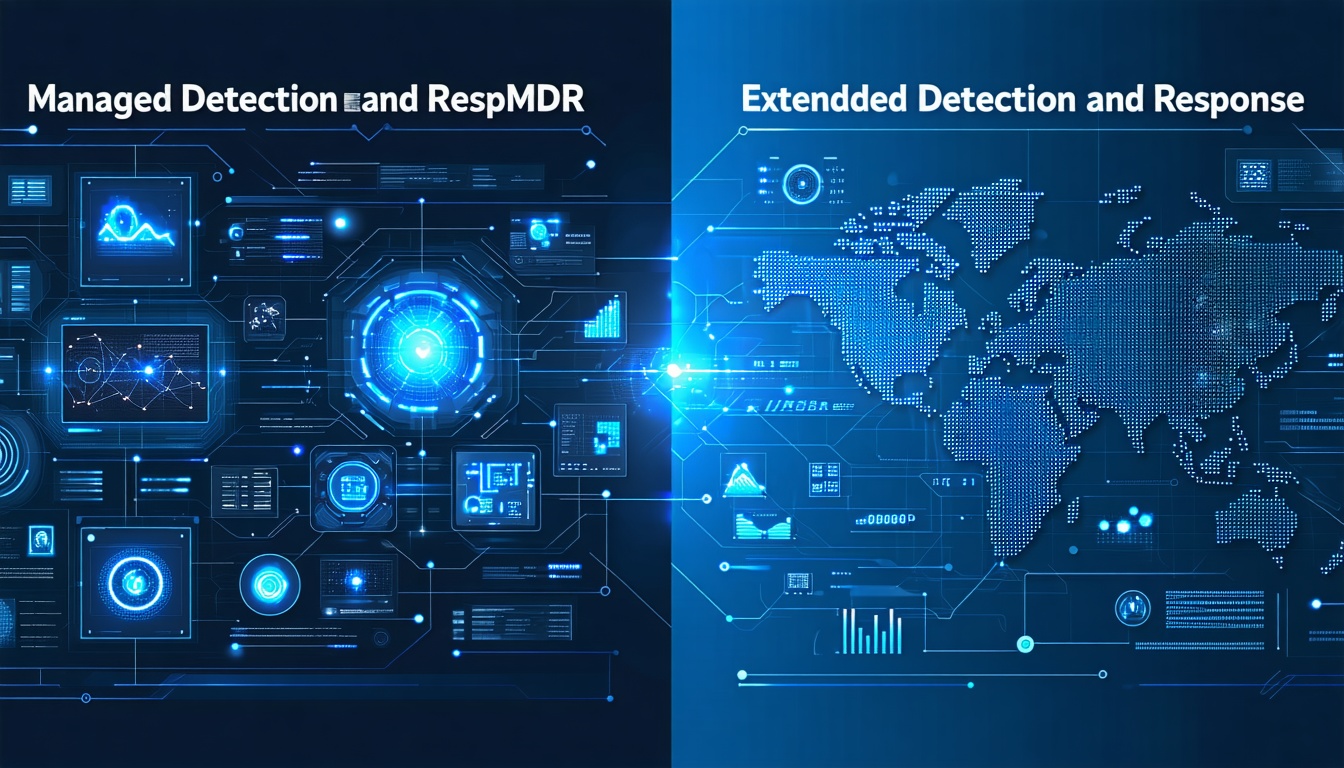Mid-sized organizations face a growing cybersecurity imperative. Recent analysis indicates that firms endure an average of 1,636 attacks weekly, with the cost of a single data breach rising to $4.88 million (Fidelis Security). Additionally, the global managed detection and response market is projected to reach $11.8 billion by 2029, at a CAGR of 23.5% (Fidelis Security). In this environment, the decision between mdr vs xdr represents a strategic crossroads, affecting detection speed, incident response, and resource allocation.
This comparison examines Managed Detection and Response and Extended Detection and Response across core capabilities, deployment models, cost drivers, and decision criteria. The goal is to guide B2B IT leaders through selecting an optimal cybersecurity framework that balances automation, human expertise, and budgetary constraints.
Understanding MDR vs XDR
Organizations evaluating mdr vs xdr must first understand the foundational differences. Managed Detection and Response, or MDR, is a turnkey service that pairs advanced security tools with expert analysts. Extended Detection and Response, or XDR, is a unified technology platform that automates telemetry collection and threat correlation across multiple domains.
What Is MDR
MDR delivers continuous monitoring, threat hunting, and incident response as a managed service. Providers typically embed the following capabilities:
- Endpoint Detection and Response with machine learning and behavioral analysis
- Proactive threat hunting by dedicated security analysts
- Integration with network and log monitoring for cross-source detection
- Incident investigation, prioritization, and remediation guidance
- Regulatory reporting support and compliance assistance (mdr compliance)
This solution offers rapid time-to-value, often reducing the mean time to detect from hundreds of days to minutes (CrowdStrike). Organizations may consult a range of managed detection and response companies to access these services without expanding in-house security operations.
What Is XDR
XDR is a product-based approach that consolidates security telemetry into a single platform. It typically includes:
- Cross-domain data collection from endpoints, networks, cloud workloads, and email systems (Microsoft Security)
- Automated correlation engines that group low-level alerts into high-priority incidents
- Integrated response actions such as endpoint isolation and threat containment
- Centralized dashboards for unified visibility and analytics
- API integrations with existing SIEM, EDR, and cloud security tools
This technology-driven model streamlines tool sprawl and can reduce manual workloads by up to 50% in high-alert environments (Fidelis Security). Organizations seeking to automate routine tasks may favor XDR, provided they have the internal expertise to manage and tune the platform.
How MDR and XDR Interrelate
In many cases, MDR and XDR are not mutually exclusive. An MDR provider can deploy XDR as the underlying telemetry engine, enriching automated correlation with human-led threat hunting. Conversely, organizations may integrate an XDR platform and supplement it with managed services to cover gaps in incident response. This hybrid approach leverages the strengths of both models, combining automation with expert analysis to optimize detection and remediation workflows. Organizations that adopt this blend often realize the broader managed cybersecurity services benefits of improved threat coverage and predictable cost structures.
Comparing Core Capabilities
A clear-eyed comparison of core security functions illuminates the relative strengths of each model. The table below outlines how MDR and XDR address critical requirements for mid-sized teams.
| Capability | MDR | XDR |
|---|---|---|
| Detection Scope | Endpoints, networks, logs | Endpoints, networks, cloud workloads, email |
| Threat Hunting | Dedicated analyst-led searches | Automated behavior and rule correlation |
| Response Model | Human-driven advice and action | Automated or semi-automated containment |
| Alert Prioritization | Expert triage with context | Correlated incidents with risk scoring |
| Compliance Support | Audit-ready reporting and guidance | Policy enforcement and automated enforcement |
| Scalability | Scales with subscription tiers | Scales with platform capacity and integrations |
| Integration Footprint | Minimal agent deployment | Dependent on tool ecosystem and APIs |
| Time-to-Value | Days to weeks with managed onboarding | Weeks to months based on integration complexity |
Detection and Response Scope
MDR leverages Endpoint Detection and Response (EDR) tools and log monitoring to detect suspicious activities at the device and network levels. XDR platforms correlate telemetry across multiple data sources, offering a holistic view that can uncover sophisticated, cross-domain threats.
Specialized Threat Hunting
Human expertise is central to MDR. Security analysts proactively search for advanced threats that automated systems may miss. In contrast, XDR uses analytics engines to flag anomalies based on predefined rules and machine learning. Organizations that require nuanced detection—such as those in regulated industries—may prioritize MDR’s proactive approach.
Automation and Incident Response
XDR accelerates response through automated playbooks that can isolate endpoints, block malicious processes, and remediate policy violations without manual intervention. MDR providers add value by guiding response actions, reducing false positive investigations, and ensuring that remediation aligns with organizational policies.
Visibility and Analytics
While both models offer dashboards and reporting, XDR excels at visualizing threat patterns across environments. MDR enriches dashboards with expert analysis, delivering prioritized alerts and actionable insights. Organizations may integrate both approaches to maximize context and accuracy.
Evaluating Deployment Models
Deployment complexity and operational overhead vary significantly between MDR and XDR. Mid-sized teams should consider service delivery, integration, and ongoing maintenance.
Service Delivery Approach
- MDR: Fully managed by a third-party security operations center. Providers handle staffing, tool updates, and process refinement.
- XDR: Self-managed or vendor-managed platform. Internal teams or managed service partners configure integrations, tuning rules, and response workflows.
MDR is ideal for organizations without a dedicated security operations center, while XDR suits those with established security teams seeking automation at scale.
Integration Requirements
XDR platforms require integration with multiple security products—SIEM, network traffic analysis, and cloud security tools. Each integration demands configuration, API management, and ongoing tuning. By contrast, MDR solutions typically deploy lightweight agents or leverage existing EDR infrastructure, minimizing disruption to operations (CrowdStrike).
Maintenance and Upgrades
MDR providers assume responsibility for system updates, threat intelligence feeds, and process optimizations. XDR users must allocate internal resources or engage a managed service partner to maintain integrations, update detection rules, and refine automated playbooks. Teams should assess their capacity for continuous platform management when choosing between the two models.
Time-to-Value Considerations
Time-to-value in MDR deployments is typically faster thanks to preconfigured workflows and expert onboarding. XDR time-to-value depends on the number and complexity of integrations; organizations with mature security stacks may see rapid gains, while those with disparate tools may require extended rollout periods.
Assessing Cost Factors
Cost considerations extend beyond licensing and subscription fees. Effective budgeting requires evaluating both direct and indirect expenses.
Cost Structure Overview
- MDR: Subscription pricing based on the number of monitored assets or endpoints. May include tiered service levels for threat hunting, compliance, and remediation support.
- XDR: Licensing fees per data source or user, plus integration and implementation costs. Additional charges may apply for feature modules or advanced analytics.
Organizations should compare the total cost of ownership, factoring in projected growth, licensing renewals, and service-level agreements.
Resource and Staffing Analysis
MDR reduces internal staffing needs by outsourcing incident response to a dedicated team. This model can lower recruitment, training, and retention costs. XDR requires skilled security engineers to manage the platform, tune detection rules, and handle escalations. Teams with limited security talent may find MDR more cost-effective in the long term.
Indirect Expenses
Both models involve indirect costs such as:
- Training and onboarding for internal teams
- Time invested in integration and platform configuration
- Opportunity cost of reallocating staff from other IT projects
By projecting these expenses, organizations gain a realistic view of budget impacts and can make data-driven investment decisions.
Choosing for Mid-Sized Teams
Mid-sized organizations often operate with constrained budgets and lean security teams. To determine the appropriate model, leaders should align security strategy with operational capacity and risk appetite.
Key Decision Criteria
- Security Maturity Level: Organizations without a dedicated SOC benefit from MDR’s managed service model.
- Technology Ecosystem: Teams with siloed tools may gain rapid value from XDR’s unified platform.
- Regulatory Requirements: Industries with strict audit mandates may require the reporting and guidance features inherent to MDR.
- Budget Predictability: Subscription-based MDR pricing can simplify budgeting compared to variable XDR licensing models.
Use-Case Scenarios
- Healthcare Provider: A hospital network adopted MDR to ensure 24/7 threat hunting, meeting compliance obligations without hiring additional analysts.
- Professional Services Firm: A consultancy firm deployed XDR to unify alerts from cloud applications and email systems, reducing manual investigations by 40%.
- Distribution Company: This team implemented a hybrid model, using XDR for automated containment and MDR for forensic analysis, accelerating incident response by 60%.
Best Practices for Implementation
- Define Scope and Objectives: Identify critical assets and priority threat vectors before selecting a model.
- Run a Pilot: Test the chosen solution on a representative subset of endpoints or workloads to measure performance and adjust configurations.
- Establish KPIs: Track metrics such as mean time to detect (MTTD), mean time to respond (MTTR), and false positive rates.
- Foster Stakeholder Collaboration: Engage IT leaders, compliance officers, and business units to align security goals with organizational objectives.
- Plan for Scale: Ensure the model can adapt to future growth—whether through additional managed service tiers or expanded platform capacity.
Conclusion and Next Steps
The decision between mdr vs xdr hinges on an organization’s security maturity, operational capacity, and strategic objectives. MDR offers a fully managed service model with expert-led threat hunting and compliance support, making it a preferred choice for teams that require immediate coverage and predictable costs. XDR, by contrast, provides a technology-centric platform for organizations seeking to unify telemetry, automate detection, and reduce manual workloads.
Mid-sized teams may also explore hybrid strategies, combining MDR and XDR to blend automation with human analysis. For deeper insights into adjacent cybersecurity models, see comparisons of mdr vs soc, mdr vs siem, and mdr vs edr. By aligning vendor capabilities with organizational priorities, IT decision makers can advance their security posture and protect critical assets against evolving threats.
Need Help with MDR vs XDR?
Looking for guidance on selecting between a managed detection and response service or an extended detection and response platform? Our experts help mid-sized organizations evaluate vendor offerings, align security requirements with budget constraints, and design pilot programs that deliver measurable outcomes. We leverage a comprehensive market guide for managed detection and response services and partner network to match specific requirements with the right provider. Let us connect you with the ideal solution and accelerate your cybersecurity journey.






